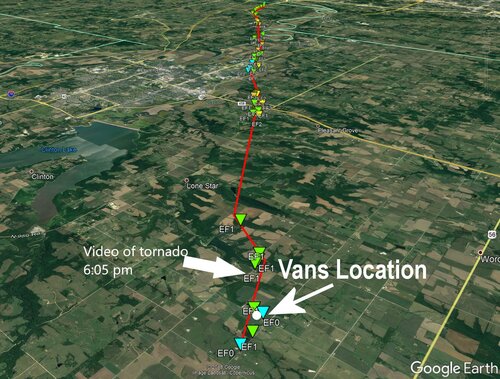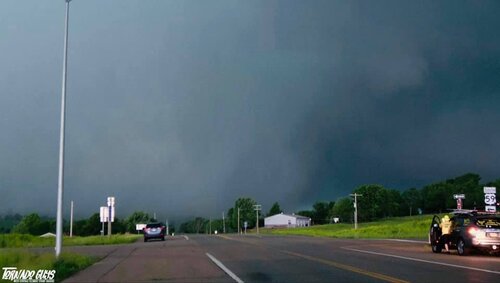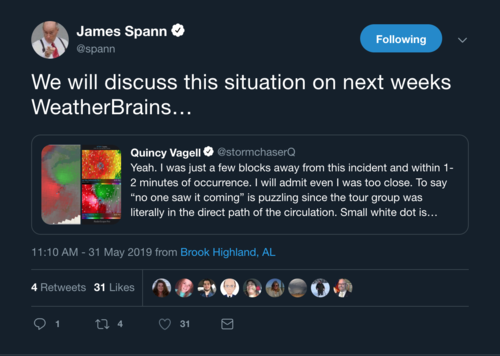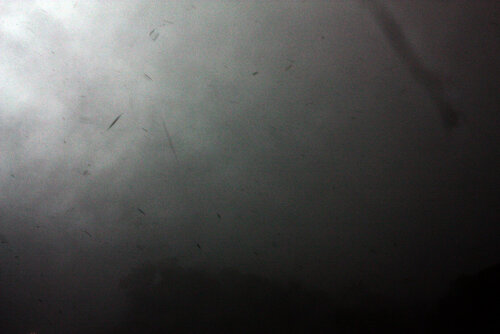Thoughts from a Tour Owner:
The approach I take when chasing on my own, vs. when I have a van full of guests is different. The risks I'm willing to take myself SHOULD be different than what guests "think" they are willing to take. First time tour guests have NO IDEA what they're getting into. So while there is assumed risk, and they've signed a waiver, when the $#!? hits the fan, all that theoretical stuff flies out the window & reality sets in very quickly.
On my first trip out stormchasing I was a passenger with Extreme Tornado Tours. And the first storm I ever chased produced an EF2 that killed three people near Kirksville, MO. That tornado impacted our van west of town and we're lucky to have escaped. The guide was so green that 20 minutes later he did it again on the east side of town, and the only reason we didn't get smacked again was Twistex turning around in a driveway, blocking our path into the 2nd tornado. Before going out, I had a conversation in my head that basically said, this is something that I want to do, and there is a risk of me dying, and I accept that risk. But when debris started impacting our van, and loose objects, branches, grass, were flying past us into the circulation as we backed up, that acceptance of risk went right out the window. I had no idea the real danger. Truthfully, it took several more years to truly understand how close we were to not making it out of there... When I started my own company, I vowed to never put my guests in that kind of position.
These incidents are far more frequent than is publicly known, for obvious reasons. It's much easier to tout our successes than to admit our failures. I know there were additional incidents during El Reno with close calls with tours. They'll continue to happen - that's the nature of what we do chasing tornadoes, but not being able to see danger is a terrible problem for a tour operator to have. If I've seen more tornadoes than anyone alive, and I've seen how close my tour was to disaster in Joplin, and close friends of mine died in El Reno, and we've had chaser deaths since then, and convergence is getting worse, then I don't know how I let a tornado that big get that close on a MDT day, in an area with hills & trees, and known flooding issues. Ultimately, it comes down to negligence.
I think most if not all tours have the waivers, and like most have said, they're more of a deterrent than a protection. I can guarantee I'm one of the FEW tours that actually carries insurance. It's incredibly hard to find and incredibly expensive. My coverage cost me on average $12,000.00 per year. It's hard to turn the corner with that high a figure. That's why most tours just don't have it. A bunch probably lie. And the only way we truly find out is when something bad happens, and everything gets exposed.
And exposure, ultimately, is what we're all arguing about here. We all know that situations happen, and we can find ourselves in bad positions. Most of us learn from those mistakes and do our best not to repeat them. There are things I did in the early days of my career I'd never do today. But the only good way to deal with those things is with transparency. And transparency is exactly the opposite of what we're getting in this incident. THERE IS NO WAY that 4 vans full of guests were that close to a tornado, on a MDT day and weren't shooting literally hundreds if not thousands of frames of photos and video. Guests take pictures & video of everything - sure they'll get tornadoes & storm structure, but most don't know what scud is. Every pointy cloud is a funnel. They don't know what's important and what's not, so they shoot everything. And here we are 4 days later and no video is online? That stinks to high heavens. To me, that means there's something to hide. To me, it indicates they've been instructed (or ordered) to not post their photos & videos. To not comment. You all know that video of that incident would bring $3,000-4,000+ from media companies starved for the next "extreme video"... Already there are inconsistencies with the "official story" and what we've put together with radar, gps, and damage surveys. Much of forecasting is pattern recognition. Connecting the dots. Maybe a big reason so many are hesitant to connect the dots in this instance is because they already know the picture it will make when they've been filled in...




